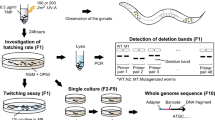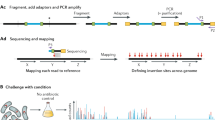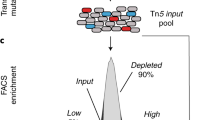Abstract
Knockout Sudoku is a method for the construction of whole-genome knockout collections for a wide range of microorganisms with as little as 3 weeks of dedicated labor and at a cost of ∼$10,000 for a collection for a single organism. The method uses manual 4D combinatorial pooling, next-generation sequencing, and a Bayesian inference algorithm to rapidly process and then accurately annotate the extremely large progenitor transposon insertion mutant collections needed to achieve saturating coverage of complex microbial genomes. This method is ∼100× faster and 30× lower in cost than the next comparable method (In-seq) for annotating transposon mutant collections by combinatorial pooling and next-generation sequencing. This method facilitates the rapid, algorithmically guided condensation and curation of the progenitor collection into a high-quality, nonredundant collection that is suitable for rapid genetic screening and gene discovery.
This is a preview of subscription content, access via your institution
Access options
Access Nature and 54 other Nature Portfolio journals
Get Nature+, our best-value online-access subscription
$29.99 / 30 days
cancel any time
Subscribe to this journal
Receive 12 print issues and online access
$259.00 per year
only $21.58 per issue
Buy this article
- Purchase on Springer Link
- Instant access to full article PDF
Prices may be subject to local taxes which are calculated during checkout







Similar content being viewed by others
References
van Opijnen, T. & Camilli, A. Transposon insertion sequencing: a new tool for systems-level analysis of microorganisms. Nat. Rev. Microbiol. 11, 435–442 (2013).
Hutchison, C.A. et al. Design and synthesis of a minimal bacterial genome. Science 351, aad6253 (2016).
Baym, M., Shaket, L., Anzai, I.A., Adesina, O. & Barstow, B. Rapid construction of a whole-genome transposon insertion collection for Shewanella oneidensis by Knockout Sudoku. Nat. Commun. 7, 13270 (2016).
Richie, D.L. et al. Identification and evaluation of novel acetolactate synthase inhibitors as antifungal agents. Antimicrob. Agents Chemother. 57, 2272–2280 (2013).
Brotcke, A. & Monack, D.M. Identification of fevR, a novel regulator of virulence gene expression in Francisella novicida. Infect. Immun. 76, 3473–3480 (2008).
Ahlund, M.K., Rydén, P., Sjöstedt, A. & Stöven, S. Directed screen of Francisella novicida virulence determinants using Drosophila melanogaster. Infect. Immun. 78, 3118–3128 (2010).
Fey, P.D. et al. A genetic resource for rapid and comprehensive phenotype screening of nonessential Staphylococcus aureus genes. MBio 4, e00537-12 (2013).
Zerikly, M., & Challis, G.L. Strategies for the discovery of new natural products by genome mining. Chembiochem 10, 625–633 (2009).
Seyedsayamdost, M.R. High-throughput platform for the discovery of elicitors of silent bacterial gene clusters. Proc. Natl. Acad. Sci. USA 111, 7266–7271 (2014).
Winzeler, E.A. et al. Functional characterization of the S. cerevisiae genome by gene deletion and parallel analysis. Science 285, 901–906 (1999).
Baba, T. et al. Construction of Escherichia coli K-12 in-frame, single-gene knockout mutants: the Keio collection. Mol. Syst. Biol. 2, 2006.0008 (2006).
Giaever, G. & Nislow, C. The yeast deletion collection: a decade of functional genomics. Genetics 197, 451–465 (2014).
van Opijnen, T., Bodi, K.L. & Camilli, A. Tn-seq: high-throughput parallel sequencing for fitness and genetic interaction studies in microorganisms. Nat. Methods 6, 767–772 (2009).
Erlich, Y. et al. DNA Sudoku--harnessing high-throughput sequencing for multiplexed specimen analysis. Genome Res. 19, 1243–1253 (2009).
Goodman, A.L. et al. Identifying genetic determinants needed to establish a human gut symbiont in its habitat. Cell Host Microbe 6, 279–289 (2009).
Goodman, A.L., Wu, M. & Gordon, J.I. Identifying microbial fitness determinants by insertion sequencing using genome-wide transposon mutant libraries. Nat. Protoc. 6, 1969–1980 (2011).
Gallagher, L.A. et al. Sequence-defined transposon mutant library of Burkholderia thailandensis. MBio 4, e00604–e00613 (2013).
Porwollik, S. et al. Defined single-gene and multi-gene deletion mutant collections in Salmonella enterica sv Typhimurium. PLoS One 9, e99820 (2014).
Gallagher, L.A. et al. Resources for genetic and genomic analysis of emerging pathogen Acinetobacter baumannii. J. Bacteriol. 197, 2027–2035 (2015).
Vandewalle, K. et al. Characterization of genome-wide ordered sequence-tagged Mycobacterium mutant libraries by Cartesian pooling-coordinate sequencing. Nat. Commun. 6, 7106 (2015).
Lane, J.M. & Rubin, E.J. Scaling down: a PCR-based method to efficiently screen for desired knockouts in a high density Mycobacterium tuberculosis picked mutant library. Tuberculosis (Edinb) 86, 310–313 (2006).
Chun, K.T., Edenberg, H.J., Kelley, M.R. & Goebl, M.G. Rapid amplification of uncharacterized transposon-tagged DNA sequences from genomic DNA. Yeast 13, 233–240 (1997).
Manoil, C. Tagging exported proteins using Escherichia coli alkaline phosphatase gene fusions. Methods Enzymol. 326, 35–47 (2000).
Jacobs, M.A. et al. Comprehensive transposon mutant library of Pseudomonas aeruginosa. Proc. Natl. Acad. Sci. USA 100, 14339–14344 (2003).
Spradling, A.C., Bellen, H.J. & Hoskins, R.A. Drosophila P elements preferentially transpose to replication origins. Proc. Natl. Acad. Sci. USA 108, 15948–15953 (2011).
Barquist, L., Boinett, C.J. & Cain, A.K. Approaches to querying bacterial genomes with transposon-insertion sequencing. RNA Biol. 10, 1161–1169 (2014).
Picelli, S. et al. Tn5 transposase and tagmentation procedures for massively scaled sequencing projects. Genome Res. 24, 2033–2040 (2014).
Deutschbauer, A. et al. Evidence-based annotation of gene function in Shewanella oneidensis MR-1 using genome-wide fitness profiling across 121 conditions. PLoS Genet. 7, e1002385 (2011).
Bouhenni, R., Gehrke, A. & Saffarini, D. Identification of genes involved in cytochrome c biogenesis in Shewanella oneidensis, using a modified mariner transposon. Appl. Environ. Microbiol. 71, 4935–4937 (2005).
Melnyk, R.A., Clark, I.C., Liao, A. & Coates, J.D. Transposon and deletion mutagenesis of genes involved in perchlorate reduction in Azospira suillum PS. MBio 5 e00769-13 (2013).
Zou, L. et al. SlyA regulates Type III Secretion System (T3SS) genes in parallel with the T3SS master regulator HrpL in Dickeya dadantii 3937. Appl. Environ. Microbiol. 78, 2888–2895 (2012).
Maier, T.M., Pechous, R., Casey, M., Zahrt, T.C. & Frank, D.W. In vivo Himar1-based transposon mutagenesis of Francisella tularensis. Appl. Environ. Microbiol. 72, 1878–1885 (2006).
Rollefson, J.B., Levar, C.E. & Bond, D.R. Identification of genes involved in biofilm formation and respiration via mini-Himar transposon mutagenesis of Geobacter sulfurreducens. J. Bacteriol. 191, 4207–4217 (2009).
Bonis, B.M. & Gralnick, J.A. Marinobacter subterrani, a genetically tractable neutrophilic Fe(II)-oxidizing strain isolated from the Soudan Iron Mine. Front. Microbiol. 6, 719 (2015).
Yu, R. & Kaiser, D. Gliding motility and polarized slime secretion. Mol. Microbiol. 63, 454–467 (2007).
Dey, A. & Wall, D. A genetic screen in Myxococcus xanthus identifies mutants that uncouple outer membrane exchange from a downstream cellular response. J. Bacteriol. 196, 4324–4332 (2014).
Zhu, L.-P. et al. Allopatric integrations selectively change host transcriptomes, leading to varied expression efficiencies of exotic genes in Myxococcus xanthus. Microb. Cell Fact. 14, 105 (2015).
Kwon, Y.M., Ricke, S.C. & Mandal, R.K. Transposon sequencing: methods and expanding applications. Appl. Microbiol. Biotechnol. 100, 31–43 (2015).
Kumar, A. Using yeast transposon-insertion libraries for phenotypic screening and protein localization. Cold Spring Harb. Protoc. 2016, http://dx.doi.org/10.1101/pdb.prot085217 (2016).
Alonso, J.M. et al. Genome-wide insertional mutagenesis of Arabidopsis thaliana. Science 301, 653–657 (2003).
Newman, D. & Kolter, R. A role for excreted quinones in extracellular electron transfer. Nature 405, 94–97 (2000).
Acknowledgements
We thank N. Ando, K. Davis, A. Palmer, S. Meisburger, B. Chang, E. Adler, K. Malzbender, and C. Kyauk for experimental assistance; W. Metcalf for providing the E. coli strain WM3064; J. Gralnick for providing Shewanella oneidensis MR-1; L. Kovacs, J. Miller, L.R. Parsons, S. Silverman, W. Wang, and J. Wiggins for assistance with next-generation sequencing and media preparation; and N. Ando for critical reading of the manuscript. This work was supported by a Career Award at the Scientific Interface from the Burroughs Wellcome Fund and Princeton University startup funds (B.B.) and Fred Fox Class of 1939 funds (I.A.A.).
Author information
Authors and Affiliations
Contributions
M.B. and B.B. conceived the Knockout Sudoku method; L.S., M.B., and B.B. conceived and designed the experiments. I.A.A., L.S., O.A., and B.B performed the experiments; I.A.A., O.A., and B.B. wrote the manuscript; I.A.A., O.A., and B.B. prepared the figures and/or tables; B.B. analyzed the data and developed the KOSUDOKU software; all authors reviewed and revised the manuscript.
Corresponding authors
Ethics declarations
Competing interests
All authors of this study are currently seeking patent protection for this method.
Integrated supplementary information
Supplementary Figure 1 Antibiotic titration of S. oneidensis progenitor collection plating.
To find the best choice of antibiotic concentration for preparing the progenitor collection we plated the S. oneidensis progenitor transposon insertion mutant library (left column) and wild-type S. oneidensis (right column) on LB agar Petri dishes with increasing concentrations of kanamycin. We chose a concentration (30 μg/mL) that was slightly higher than that necessary to eliminate the appearance of wild-type colonies and that eliminated the appearance of a lawn of transposon insertion mutants.
Supplementary Figure 2 Testing the freeze-thaw tolerance of the S. oneidensis progenitor collection.
Plate 4 from the S. oneidensis progenitor collection was repeatedly thawed and re-frozen and at each step a new copy was made and the number of surviving mutants on the plate was recorded. This indicates that under the conditions used to preserve the collection (LB with 30 μg/mL kanamycin mixed with an equal volume of 20% v/v glycerol), a plate can withstand at least three thaw-freeze cycles.
Supplementary Figure 3 Molecular weight distribution of progenitor collection pool amplicon libraries
The molecular weight distributions of the amplicon libraries generated from the pooled S. oneidensis progenitor collection were measured by gel electrophoresis on 1% w/v agarose gel in TAE buffer. The gel was run at 150 V for 30 minutes. Amplicon libraries were also generated from wild-type S. oneidensis (SoG); a single mutant with a disruption in the phosphate acetyltransferase gene (Δpta); and a blank sample (Blank).
Supplementary Figure 4 Molecular weight distribution of condensed collection pool amplicon libraries.
The molecular weight distributions of the amplicon libraries generated from the pooled S. oneidensis condensed collection were measured by gel electrophoresis on 1% w/v agarose-TAE gel. The gel was run at 150 V for 30 minutes. Amplicon libraries were also generated for a blank sample (Blank).
Supplementary Figure 5 Purification and size selection of combined pool amplicon libraries.
The amplicon libraries generated from the pooled amplicon libraries were purified by molecular weight prior to next generation sequencing by agarose gel electrophoresis. Approximately 3 μg of DNA from the combined amplicon generation reactions was loaded onto an 8.3 cm long 2% w/v agarose-TAE gel. The gel was run at 150 V for 30 minutes. Immediately after the voltage was removed, the portion of the gel containing amplicons with molecular weights between 500 and 1,000 bp was removed with a scalpel and purified by gel extraction.
Supplementary information
Supplementary Text and Figures
Supplementary Figures 1–5, Supplementary Tables 1–6, and Supplementary Data 1–13. (PDF 23076 kb)
Combinatorial pooling process for Knockout Sudoku.
Knockout Sudoku uses a 96-channel pipettor to pool a 96-well plate in four pipetting operations. (i) All wells are pooled into row pools (A–H) using a specialized row tray. (ii) All wells are pooled into column pools (1–12) using a specialized column tray. (iii) All wells are pooled by plate column using an OmniTray specific to the plate's plate column (PC1–PC4 in the example in Figure 1). (iv) All wells are pooled by plate row using an OmniTray specific to the plate's plate row (PR1–PR4 in the example in Figure 1). (MP4 26513 kb)
Rights and permissions
About this article
Cite this article
Anzai, I., Shaket, L., Adesina, O. et al. Rapid curation of gene disruption collections using Knockout Sudoku. Nat Protoc 12, 2110–2137 (2017). https://doi.org/10.1038/nprot.2017.073
Published:
Issue Date:
DOI: https://doi.org/10.1038/nprot.2017.073
This article is cited by
-
A genetic system for Akkermansia muciniphila reveals a role for mucin foraging in gut colonization and host sterol biosynthesis gene expression
Nature Microbiology (2023)
-
Genomic characterization of rare earth binding by Shewanella oneidensis
Scientific Reports (2023)
-
Generation of a Gluconobacter oxydans knockout collection for improved extraction of rare earth elements
Nature Communications (2021)
-
Rapid ordering of barcoded transposon insertion libraries of anaerobic bacteria
Nature Protocols (2021)
-
Identification of a pathway for electron uptake in Shewanella oneidensis
Communications Biology (2021)
Comments
By submitting a comment you agree to abide by our Terms and Community Guidelines. If you find something abusive or that does not comply with our terms or guidelines please flag it as inappropriate.



